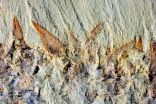(Press-News.org) Nidelric pugio fossil dates to half a billion years ago and teaches us about the diversity of life in Earth's ancient seas
In life the animal was a 'balloon' shape and was covered in spines, but the squashed fossil resembles a bird's nest
Named in honour of Professor Richard Aldridge from the University of Leicester
A rare 520 million year old fossil shaped like a 'squashed bird's nest' that will help to shed new light on life within Earth's ancient seas has been discovered in China by an international research team - and will honour the memory of a University of Leicester scientist who passed away earlier this year.
The research team behind the discovery was led by Professor Xianguang Hou from the Yunnan Key Laboratory for Palaeobiology at Yunnan University in China with collaboration from the Universities of Leicester and Oxford.
The fossil, from Chengjiang in southern China, is of a probable 'chancelloriid', a group of bizarre, balloon-shaped animals with an outer skeleton of defensive spines. The animal was flattened during the fossilisation process so that it looks like a squashed bird's nest.
Funded by the National Science Foundation in China and the Royal Society in the UK, the research team named the species Nidelric pugio to honour the late Professor Richard Aldridge, an internationally renowned palaeontologist and keen ornithologist formerly of the University of Leicester's Department of Geology and a scientist who was a world leader in Chengjiang fossil research.
The name of the fossil is derived from the Latin Nidus, meaning 'bird's nest' or 'fancied resemblance to' and adelric, derived from the Old English personal name 'Aedelic' - 'adel' meaning 'noble' and 'ric' meaning 'a ruler'- which is a source for the name Aldridge.
Dr Tom Harvey from the University of Leicester, a co-author of the paper, said: "There is only one fossil of this enigmatic animal after 30 years of collecting by our Chinese colleagues at Chengjiang. It is exceptionally rare, but it shows us just how strange and varied the shapes of early animals could be.
"We are glad the fossil can honour the name of Professor Richard Aldridge, who was a leader in this field and whose research was vital in better understanding the rich tapestry of fossils found at Chengjiang."
In southern China, rocks 520 million years old in Chengjiang County, Yunnan Province yield a diverse array of fossils preserved with traces of their soft anatomy, including their legs, eyes, guts and even brains.
Amongst the fossils are many animals that can be related to modern forms, including distant relatives of arthropods such as crabs and lobsters, and a wide variety of worms.
There are also several enigmatic fossils that don't seem to fit in with anything living today, and amongst these are the chancelloriids.
These fossils provide an unprecedented view of life in Earth's ancient seas.
Tom Hearing, a PhD student from the Department of Geology who is working on the skeletons of Cambrian fossils, added: "We usually only get the broken-up remains of ancient animal skeletons. With this specimen we can see how all the different parts of the skeleton stuck together. It tells us much about how early animals functioned, how they might have interacted with other animals, and how they might have protected themselves from predators."
INFORMATION:
The paper, 'A chancelloriid-like metazoan from the early Cambrian Chengjiang Lagerstätte, China', authored by Professor Aldridge's friends and colleagues Xianguang Hou, Mark Williams, David Siveter, Derek Siveter, Sarah Gabbott, David Holwell and Thomas Harvey is published in the journal Scientific Reports on 9 December 2014 and will be available here: http://dx.doi.org/10.1038/srep07340.
Notes to editors:
For more information please contact Dr Tom Harvey on 0116 252 3644 or email thph2@le.ac.uk
About The Royal Society
The Royal Society is a self-governing Fellowship of many of the world's most distinguished scientists drawn from all areas of science, engineering, and medicine. The Society's fundamental purpose, as it has been since its foundation in 1660, is to recognise, promote, and support excellence in science and to encourage the development and use of science for the benefit of humanity.
The Society's strategic priorities emphasise its commitment to the highest quality science, to curiosity-driven research, and to the development and use of science for the benefit of society. These priorities are:
1. Promoting science and its benefits
2. Recognising excellence in science
3. Supporting outstanding science
4. Providing scientific advice for policy
5. Fostering international and global cooperation
6. Education and public engagement
For further information please visit royalsociety.org Follow the Royal Society on Twitter at http://twitter.com/royalsociety or on Facebook at http://www.facebook.com/theroyalsociety
Montreal, Canada, November x, 2014 - Angiochem, a clinical stage biotechnology company creating and developing drugs that cross the blood-brain barrier, today announced the publication in Molecular Cancer Therapeutics demonstrating that ANG4043, a peptide-monoclonal antibody (mAb) conjugate, entered the brain at therapeutic concentrations, resulting in significantly prolonged survival in mice. The antibody is directed against HER2, which is the protein targeted by Herceptin®. Because the mAb is conjugated to Angiopep-2, it is recognized by the LRP1 receptor and takes ...
Phoenix, AZ (December 9th, 2014) - Healthy, elderly research participants who report being more sleepy and less rested have higher levels of amyloid deposition in regions of the brain that are affected in Alzheimer's disease, according to a report presented today at the American College of Neuropsychopharmacology annual meeting in Phoenix (Arizona). If sleep disturbance is a cause of amyloid accumulation, it may be an early target for intervention to prevent the progression of cognitive deficits in late life.
Numerous studies have shown the importance of sleep and the ...
Phoenix, AZ (December 9th, 2014) - Abnormalities in the prefrontal cortex and related brain areas are observed in adolescents who have attempted suicide, according to a report today at the American College of Neuropsychopharmacology annual meeting in Phoenix Arizona. The study suggests that deficits in frontal systems may be associated with risk for suicide attempts in youths with mood disorders.
Most suicide attempts occur in the context of mood disorders, including bipolar disorder and major depressive disorder. Bipolar disorder has a prevalence of 3-4% in the U.S. population, ...
A multicenter phase 1 trial of the immune checkpoint blocker ipilimumab found clinical benefit in nearly half of blood cancer patients who had relapsed following allogeneic stem cell transplantation, according to investigators from Dana-Farber Cancer Institute, who developed and lead the study.
The study reported at the American Society of Hematology annual meeting is the first in which ipilimumab was given in multiple doses over an extended time period, the researchers said.
At a median follow-up time of six months, "We have seen less toxicity than expected and a strong ...
A study that investigated the potential of the compound PRM-151 (PRM) for reducing progressive bone marrow fibrosis (scarring) in patients with advanced myelofibrosis has shown initial positive results. Myelofibrosis is a life-threatening bone marrow cancer.
The study, led by Srdan Verstovsek, M.D., Ph.D., professor of leukemia at The University of Texas MD Anderson Cancer Center, showed the compound was well tolerated in observing 27 patients. Verstovsek's research results were presented today at the 56th Annual Meeting of the American Society of Hematology (ASH) annual ...
Aiming to empower planners and policy-makers to achieve better health for billions of people living in fast-growing urban areas, world health, environmental, behavioural and social science experts today launched a major new interdisciplinary scientific collaboration.
Programme goals:
Empowering planners and policy-makers with better science to create healthy urban environments and improve wellbeing;
Identify and manage unintended health consequences of urban policy;
Understand connections between cities and planetary change
Leading the consortium of science ...
Opposing views on the potential impact of electronic cigarettes on public health are published in the open access journal BMC Medicine. The commentaries, by two experts, differ in their views on the topic but are united in their call for a rational discussion based on evidence.
The authors examine the WHO's recommendations earlier this year. One recommendation was that smokers should not use e-cigarettes and has now been withdrawn, and the other is that policymakers should implement their strict regulation, which is still in force.
In one of the commentaries, Peter ...
Sophia Antipolis, 09 December 2014: Heart disease patients have been advised to avoid being outside during rush hour traffic in a paper published today in European Heart Journal.1 The position paper on air pollution and cardiovascular disease was written by experts from the European Society of Cardiology and also recommends decreasing the use of fossil fuels.
Professor Robert F. Storey, corresponding author of the paper, said: "More than 3 million deaths worldwide are caused by air pollution each year. Air pollution ranks ninth among the modifiable disease risk factors, ...
There is no need to spray insecticide on walls for malaria control when people sleep under treated bed nets, according to new research.
Use of insecticide sprayed on internal walls, when combined with insecticide-treated bed nets in homes, does not protect children from malaria any more effectively than using just insecticide-treated bed nets, the research led by Durham University and the Medical Research Council's Unit in The Gambia found.
The researchers said this was important as insecticide-treated nets and insecticide sprayed on walls are commonly used for controlling ...
The system that allows patients rapid access to expensive new treatments lacks transparency and penalises small and low-income countries unable to negotiate lower prices with pharmaceutical manufacturers. Writing in the Journal of the Royal Society of Medicine, the authors of an essay on market-access agreements for anti-cancer drugs, say that while the underlying strategy is to help reduce the likelihood of health systems paying for treatments that turn out not to be cost-effective, the agreements can also be seen as an opportunistic way for pharmaceutical manufacturers ...



